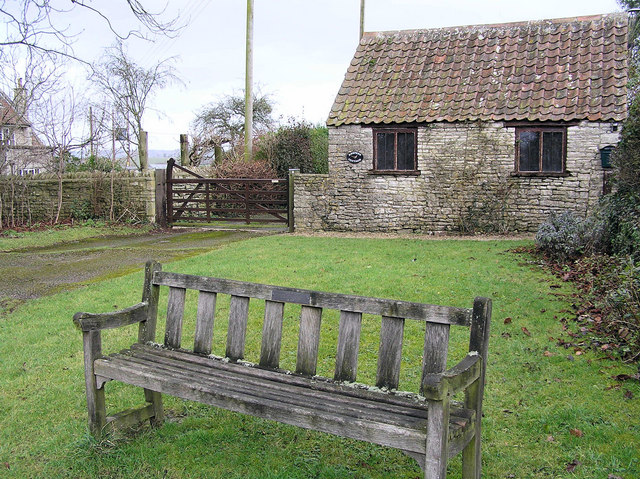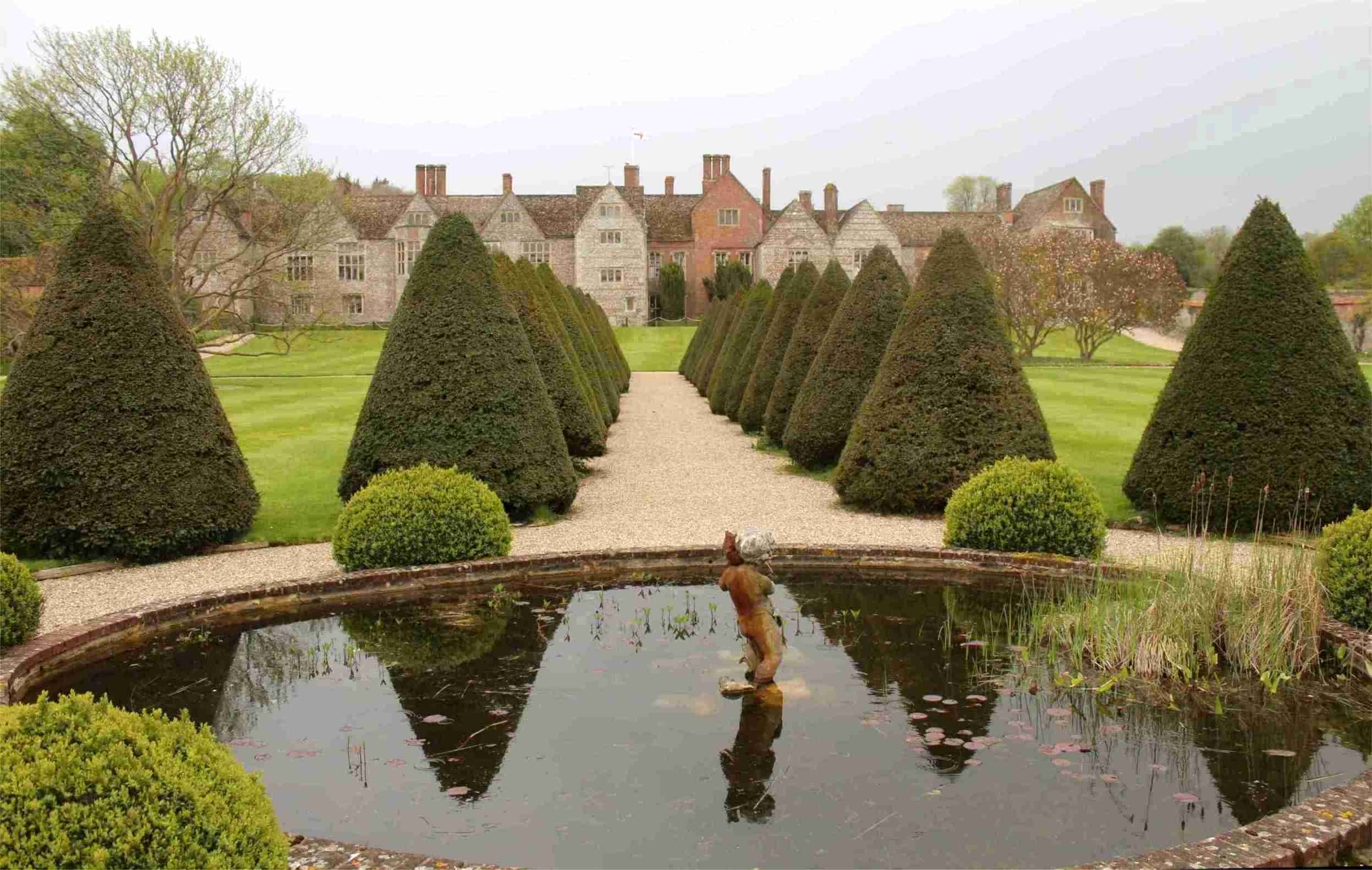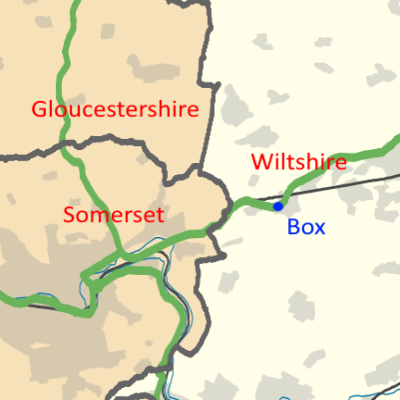|
Church Of St Peter, Marksbury
The Church of St Peter in Marksbury, Somerset, England dates from the 12th century, although most of the current fabric is from the 15th century and is a Grade II* listed building. The nave has two 2-light windows under hood moulds flanking a blocked, moulded round-headed door under a plaque dated 1627. The buttressed, off-centre chancel, which is out of line with the nave, has a three-light east window from 1875, which was also when the chancel arch and chancel roof were replaced. The organ chamber was built in 1893. The altar is a Jacobean oak table by Francis Leyborne Popham who died in 1880. A second altar table, which was previously in the church at Stanton Prior, was placed in the tower. The font is Norman. The three stage tower is supported by diagonal buttresses to the first stage, a canted stair turret in the return of tower and nave and a very small west door with a canted flat arch under a two-light, chamfered mullion window dating from 1634. The second stage has a ... [...More Info...] [...Related Items...] OR: [Wikipedia] [Google] [Baidu] |
Marksbury
Marksbury is a small village and civil parish on the eastern edge of the affluent Chew Valley in Somerset, about from Keynsham and from Bath on the A39 where it meets the A368. The parish, which includes the villages of Hunstrete and Stanton Prior, has a population of 397. History Stantonbury Camp is the site of an Iron Age hillfort near Stanton Prior. It is a Scheduled Ancient Monument. The hillfort, which is at the top of an isolated outcrop of Oolitic Limestone, close to the A39 road is on the route of the Wansdyke. In 926 Æthelstan gave the manor, then spelled Merkesburie, to his son. It was later gifted to Glastonbury Abbey and in one of the Danelaw wars was taken by Danish troops. It was restored to the abbey again after the victory of Edgar the Peaceful. Marksbury was listed in the Domesday Book of 1086 as ''Mercesberia''. The name of the village is thought to come from Old English either as ‘Mǣrec’s or Mearc’s stronghold’ (from an Old English male ... [...More Info...] [...Related Items...] OR: [Wikipedia] [Google] [Baidu] |
Parapet
A parapet is a barrier that is an extension of the wall at the edge of a roof, terrace, balcony, walkway or other structure. The word comes ultimately from the Italian ''parapetto'' (''parare'' 'to cover/defend' and ''petto'' 'chest/breast'). Where extending above a roof, a parapet may simply be the portion of an exterior wall that continues above the edge line of the roof surface, or may be a continuation of a vertical feature beneath the roof such as a fire wall or party wall. Parapets were originally used to defend buildings from military attack, but today they are primarily used as guard rails, to conceal rooftop equipment, reduce wind loads on the roof, and to prevent the spread of fires. In the Bible the Hebrews are obligated to build a parapet on the roof of their houses to prevent people falling (Deuteronomy 22:8). Parapet types Parapets may be plain, embattled, perforated or panelled, which are not mutually exclusive terms. *Plain parapets are upward extensions of ... [...More Info...] [...Related Items...] OR: [Wikipedia] [Google] [Baidu] |
Church Of England Church Buildings In Bath And North East Somerset
Church may refer to: Religion * Church (building), a building for Christian religious activities * Church (congregation), a local congregation of a Christian denomination * Church service, a formalized period of Christian communal worship * Christian denomination, a Christian organization with distinct doctrine and practice * Christian Church, either the collective body of all Christian believers, or early Christianity Places United Kingdom * Church (Liverpool ward), a Liverpool City Council ward * Church (Reading ward), a Reading Borough Council ward * Church (Sefton ward), a Metropolitan Borough of Sefton ward * Church, Lancashire, England United States * Church, Iowa, an unincorporated community * Church Lake, a lake in Minnesota Arts, entertainment, and media * '' Church magazine'', a pastoral theology magazine published by the National Pastoral Life Center Fictional entities * Church (''Red vs. Blue''), a fictional character in the video web series ''Red vs. Blue'' * Chur ... [...More Info...] [...Related Items...] OR: [Wikipedia] [Google] [Baidu] |
List Of Ecclesiastical Parishes In The Diocese Of Bath And Wells
The ecclesiastical parishes within the Diocese of Bath and Wells cover the majority of the ceremonial counties of England, English county of Somerset and small areas of Devon, Dorset, Gloucestershire and Wiltshire. The cathedra, episcopal seat of the Bishop of Bath and Wells is in the Wells Cathedral, Cathedral Church of Saint Andrew in the city of Wells, Somerset, Wells in Somerset. The diocesan offices, the bishops' offices and residences and the cathedral are all located around the Bishop's Palace, Wells, Bishop's Palace in Wells. The diocese is not referred to as "Bath diocese" or "Wells diocese", but as "Bath and Wells diocese". The ordinary of the diocese is the diocesan Bishop of Bath and Wells, Peter Hancock; he is assisted throughout the diocese by the Bishop of Taunton, Bishop suffragan of Taunton, Ruth Worsley. Her See was created in 1911. Alternative episcopal oversight (for parishes in the diocese that reject the ministry of women priests) is provided by the provi ... [...More Info...] [...Related Items...] OR: [Wikipedia] [Google] [Baidu] |
Cheddar Cheese
Cheddar cheese (or simply cheddar) is a natural cheese that is relatively hard, off-white (or orange if colourings such as annatto are added), and sometimes sharp-tasting. Cheddar originates from the English village of Cheddar in Somerset. Cheddar cheese is produced all over the world, and ''cheddar cheese'' has no protected designation of origin either in the United Kingdom or the European Union. In 2007, the protected designation of origin name "West Country Farmhouse Cheddar" was registered in the EU and (after Brexit) the UK, defined as cheddar produced from local milk within Somerset, Dorset, Devon and Cornwall and manufactured using traditional methods. Protected Geographical Indication (PGI) was registered for ''Orkney Scottish Island Cheddar'' in 2013 in the EU, which also applies under UK law. Globally, the style and quality of cheeses labelled as cheddar may vary greatly, with some processed cheeses being packaged as "cheddar". Furthermore, certain cheeses that are sim ... [...More Info...] [...Related Items...] OR: [Wikipedia] [Google] [Baidu] |
Joseph Harding
Joseph Harding (22 March 1805 in Sturton Farm, Wanstrow, Somerset, England – 1 May 1876 in Vale Court Farm, Marksbury, Somerset) was responsible for the introduction of modern cheese making techniques and has been described as the "father of Cheddar cheese". He is credited with having invented the "definite formula" for the production of cheddar cheese. A number of websites describe him as the inventor of the Cheese Mill.History of Cheddar – Cheddar Cheese – Icons of England It is unclear if this assertion is true. The cheese mill is different from the cheese press, which has b ... [...More Info...] [...Related Items...] OR: [Wikipedia] [Google] [Baidu] |
River Chew
The River Chew is a small river in England that flows for some through the North Somerset countryside to form the Chew Valley before merging with the River Avon. The spring from which the Chew rises is just upstream from Chewton Mendip. The river flows northwest from Chewton Mendip through Litton, Chew Valley Lake, Chew Stoke, Chew Magna, and Stanton Drew. The river passes under the A37 at Pensford; flows through the villages of Publow, Woollard, Compton Dando, and Chewton Keynsham; and joins the River Avon at Keynsham. The Two Rivers Way runs alongside the Chew for much of its distance, forming part of the Monarch's Way. The name "Chew" The name "Chew" may have Celtic origins, cognate with the River Chwefru, ''cliwyf-ffrenwy'', "the moving, gushing water"; ancient forms are ''Estoca'' (Chew Stoke), ''Chiu'' (Chew Magna), and ''Ciwetune'' (Chewton Mendip). Its exact meaning admits of several possible explanations, including "winding water", the ''ew'' being a variant of ... [...More Info...] [...Related Items...] OR: [Wikipedia] [Google] [Baidu] |
Great Flood Of 1968
The Great Flood of 1968 was a flood caused by a pronounced trough of low pressure which brought exceptionally heavy rain and thunderstorms to South East England and France in mid-September 1968, with the worst on Sunday 15 September 1968, and followed earlier floods in South West England during July. This was likely the severest inland flood experienced in the Home Counties during the last 100 years. The areas worst hit were Crawley, East Grinstead, Horley, Lewisham, Petersfield, Redhill, Tilbury, Tunbridge Wells and Tonbridge. On 15 September 1968, the 9:50 Charing Cross to Hastings was diverted along the Edenbridge line, but was surrounded by flood water at Edenbridge railway station. 150 passengers spent 12 hours stuck on the train. France In the first seven hours of 15 September 1968 three inches of rain fell on Nice. In Toulon a cyclist was killed by an electricity cable that had fallen into the flooded road. The wine harvest was seriously damaged. See also * 19 ... [...More Info...] [...Related Items...] OR: [Wikipedia] [Google] [Baidu] |
Hunstrete
Hunstrete () is a small village on the River Chew in the Chew Valley, Bath and North East Somerset, England. It falls within the civil parish of Marksbury and is from Bristol, and Bath, and from Keynsham. History The origin of the name Hunstrete is unclear. One explanation is that it means 'The hundred road' from the Old English ''hund'' and ''street''. Other possible derivations are the personal name ''hund'' and Old English ''steort'' meaning a projecting piece of land, or ''hund'', meaning hound or dog, relating to the place where they were kept. Although occupation during the Iron Age is possible the earliest evidence are Roman coins from the emperor Carausius, and continuous occupation during the Saxon period may have been connected with the nearby Wansdyke. A charter of 936 suggests the land was given to a thegn by the name of Ethelelm by Æthelstan. The manor was granted to Glastonbury Abbey who held it until the dissolution of the monasteries in 1539 when it was ... [...More Info...] [...Related Items...] OR: [Wikipedia] [Google] [Baidu] |
Littlecote House
Littlecote House is a large Elizabethan country house and estate in the civil parishes of Ramsbury and Chilton Foliat, in the English county of Wiltshire, about northeast of the Berkshire town of Hungerford. The estate includes 34 hectares of historic parklands and gardens, including a walled garden dating from the 17th and 18th centuries. In its grounds is Littlecote Roman Villa. A Grade I listed building, Littlecote House is now a hotel and leisure centre. History Early house The first Littlecote House was built during the 13th century and was the home of the de Calstone family from around 1290. In 1415 Elizabeth de Calstone married William Darrell and the Darrell family inherited the estate. Elizabeth Darrell's half-niece, also named Elizabeth Darrell, was a maid of honour to Henry VIII's first queen Catherine of Aragon and had a well-publicised affair with the poet Sir Thomas Wyatt. 16th century In the mid-1530s, King Henry VIII is said to have courted his third wif ... [...More Info...] [...Related Items...] OR: [Wikipedia] [Google] [Baidu] |
Box, Wiltshire
Box is a large village and civil parish within the Cotswolds Area of Outstanding Natural Beauty in Wiltshire, England, about west of Corsham and northeast of Bath. Box also falls in the easternmost part of the Avon Green Belt. Besides the village of Box, the parish includes the villages of Ashley and Box Hill; Hazelbury manor; and the hamlets of Alcombe, Blue Vein, Chapel Plaister, Ditteridge, Henley, Kingsdown, Middlehill, and Wadswick. To the east the parish includes much of Rudloe, formerly a hamlet but now a housing estate, and the defence establishments and related businesses on the site of RAF Rudloe Manor. Occupation here dates back at least to Roman times. The area is known for its fine stone and for centuries Box quarries were famous for their product. Today Box is perhaps better known for its Brunel-designed Box railway tunnel. Box has been twinned with Sorigny, a commune in central France, since 2016. Geography Box lies in Wiltshire, close to the bounda ... [...More Info...] [...Related Items...] OR: [Wikipedia] [Google] [Baidu] |
Chew Stoke
Chew Stoke is a small village and civil parish in the affluent Chew Valley, in Somerset, England, about south of Bristol and 10 miles north of Wells. It is at the northern edge of the Mendip Hills, a region designated by the United Kingdom as an Area of Outstanding Natural Beauty, and is within the Bristol/ Bath green belt. The parish includes the hamlet of Breach Hill, which is approximately southwest of Chew Stoke itself. Chew Stoke has a long history, as shown by the number and range of its heritage-listed buildings. The village is at the northern end of Chew Valley Lake, which was created in the 1950s, close to a dam, pumping station, sailing club, and fishing lodge. A tributary of the River Chew, which rises in Strode, runs through the village. The population of 991 is served by one shop, one working public house, a primary school and a bowling club. Together with Chew Magna, it forms the ward of Chew Valley North in the unitary authority of Bath and North East Somerset ... [...More Info...] [...Related Items...] OR: [Wikipedia] [Google] [Baidu] |





